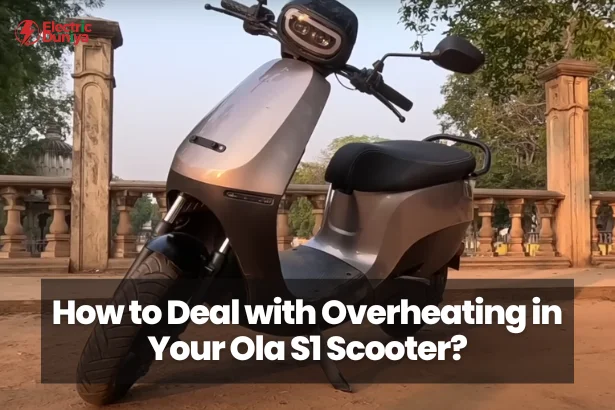Oof. That sizzling feeling under your seat? Yeah, your scooter’s practically sweating buckets—and that’s not normal.
If your Ola S1 scooter is heating up more than it should, don’t freak out just yet. I’ve been there (unfortunately, in the middle of traffic on a 38°C day). Whether it’s because of soaring summer temperatures, mechanical hiccups, or just plain overuse, overheating is a common issue—but one that’s manageable.
In this guide, I’ll walk you through exactly what I do when my Ola gets too hot to handle. You’ll learn how to spot the signs early, cool it down quickly, and stop it from happening again. Let’s get into it.
1. Recognize the Signs of Overheating.
You know that uneasy feeling when something doesn’t sound right, smell right, or feel right with your ride? Trust your gut—your scooter’s giving you signals. Here’s how to decode them:
- Temperature Gauge Freakout: If your dashboard is flashing warning signs or the temperature needle is climbing into the danger zone, your scooter’s thermal regulation is in distress.
- Weird Engine Noises: When things get too hot inside, metal parts can expand unnaturally, fluids start to bubble, and you might hear ticking, knocking, or even whining sounds from under the hood.
- Sudden Power Drop: Ever had your scooter feel like it’s just given up halfway through a ride? That’s thermal overload—the engine cuts power to prevent permanent damage.
- Burning or Sweet Smells: A hot coolant leak often smells sweet, while overheated oil or wiring might smell burnt. Neither is a good sign.
Knowing these red flags could save your engine from serious harm.
2. Stop and Cool Down.
I can’t stress this enough—stop riding immediately if you sense overheating. Riding through it only worsens the damage. I usually pull over, switch off the ignition, and just let the poor thing rest.
Engines—especially electric motors with integrated thermal systems—need time to dissipate heat before you restart. Trust me, patience here saves money later.
3. Check Cooling System Components.
Once the scooter has cooled down (give it 15–30 minutes), it’s time to play detective.
- Coolant Levels: Your Ola S1 has a coolant reservoir under the seat. It’s usually semi-transparent with “MIN” and “MAX” markings. If the level is too low, you might have a leak—or you’ve just run low. Either way, refill using manufacturer-recommended antifreeze.
- Cooling Fan Check: If your cooling fan isn’t spinning when the engine’s hot, that’s a problem. It’s like a ceiling fan on a scorching day—it has to work. If not, you may need a technician to replace it.
Don’t worry if you’re not mechanically inclined. A quick visual check and a feel for airflow near the vent will tell you most of what you need to know.
4. Monitor Your Ride
Here’s where riding habits matter more than people think.
During peak summer months or in stop-and-go traffic, scooters (especially EVs) are more prone to heat buildup. When I know I’ll be stuck at signals or crawling through market roads, I take preemptive breaks—park in the shade, grab a chai, let the system chill out.
Also, avoid riding at top speed for extended periods when the air temperature is high. The air-cooling isn’t enough, and your scooter can overheat faster than you expect.
5. Are You Maintaining it Regularly?
One of the biggest mistakes I see people make (yep, guilty here too once) is skipping scheduled service. EVs are often seen as “low-maintenance,” but that doesn’t mean no maintenance.
Get your scooter inspected regularly—especially the thermal system, battery compartment, and airflow mechanisms. Make sure any worn-out seals, hoses, or coolant caps are replaced early.
Your ride isn’t just a machine; it’s an interconnected system. If one part fails, others compensate—and that can lead to overheating.
6. Check for Mechanical Issues
Sometimes, overheating isn’t just about hot weather or clogged vents. It can be symptomatic of deeper problems—battery management issues, faulty sensors, poor thermal paste application, or even internal resistance build-up.
When in doubt, head to your nearest Ola service center. Their diagnostic tools can run a thermal profile and pinpoint exact faults. Don’t DIY what’s meant for pros.
7. Avoid Overloading
Look—I get it. We’ve all carried more than we should. But these scooters aren’t built for cross-country cargo runs. Overloading your Ola S1 (passengers or packages) strains the motor and increases internal heat generation.
Stick to the manufacturer’s load limit, and if you’re carrying groceries, tools, or equipment often, try balancing the load or using saddlebags designed for airflow.
Final Thoughts
At the end of the day, overheating doesn’t mean your scooter’s on its last leg. It’s just your Ola telling you, “Hey, I need a break.”
Stay proactive, stay aware, and don’t ignore the signs. A few quick checks and some good riding habits can make a world of difference.
And if things ever feel out of your depth? Trust your gut—and your technician.







